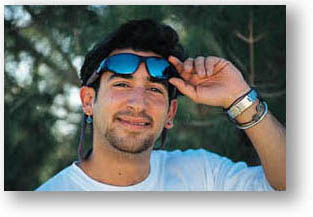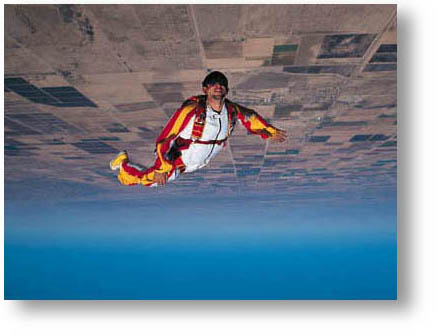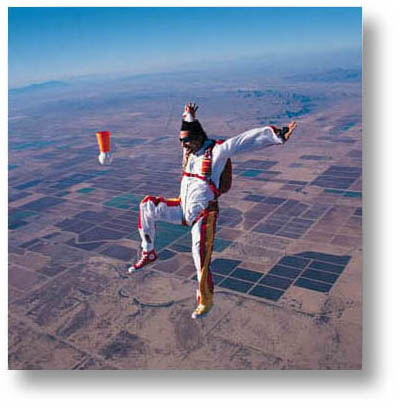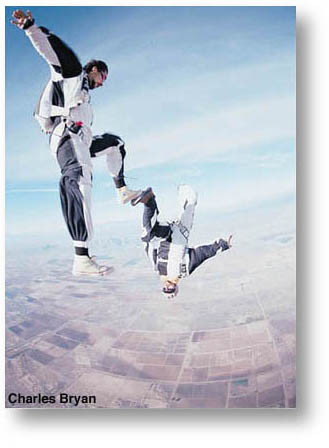
Article of the month :
Omar : an open hearted world champion

This month meet Omar Alhegelan. The
man is likeable and lives his dreams in the freeflying universe. He opened
its door with Olav and now he follows his multidimensional path.
Interview et
photos by Patrick Passe
 For
Omar, freeflying is much more than what most head-down flyers make of it.
Omar is very good at inverted flight but he is also a mighty stand-up or
sit-flyer. He is the freestyle world champion but most of all he is a sensitive
man with great human qualities. He is a 32 years old Saudian. He used to
travel a lot during his childhood, following his father, an ambassador
for Saudi Arabia in several countries. Born in Spain, Omar spent 3 years
there. He then lived for 7 years in Venezuela, 2 years in Denmark, 3 years
in England, 4 years in Washington, D. C. and spent many holidays in France.
Such a childhood was a chance sheer luck for him since he got to learn
many languages. He can now speak fluently Arab, English, Spanish, French
and Italian and he also got to know other cultures and different mentalities.
Let us go together through his skydiving history and his beliefs.
For
Omar, freeflying is much more than what most head-down flyers make of it.
Omar is very good at inverted flight but he is also a mighty stand-up or
sit-flyer. He is the freestyle world champion but most of all he is a sensitive
man with great human qualities. He is a 32 years old Saudian. He used to
travel a lot during his childhood, following his father, an ambassador
for Saudi Arabia in several countries. Born in Spain, Omar spent 3 years
there. He then lived for 7 years in Venezuela, 2 years in Denmark, 3 years
in England, 4 years in Washington, D. C. and spent many holidays in France.
Such a childhood was a chance sheer luck for him since he got to learn
many languages. He can now speak fluently Arab, English, Spanish, French
and Italian and he also got to know other cultures and different mentalities.
Let us go together through his skydiving history and his beliefs.
ParaMag : Tell us about your skydiving
first steps.
Omar : I started skydiving in November 1993
on a small DZ which does not exist anymore and which was located in the
suburbs of Washington, D.C.. I graduated from AFF after 5 jumps instead
of 7 and then proceeded with Skydive University. For my 22nd jump, I took
part in an excellent 4-way RW jump where we built 13 formations. It will
remain an unforgettable memory for the beginner I was. I rapidly got hooked
but the pace of that small DZ did not fulfil my expectations anymore. We
would jump out of a Cessna and most people would come only to make 2 or
3 jumps during the week end. The 4-way RW jumps I used to make were becoming
boring. Most of the time, we were waiting would wait for someone under
the formation or slow to dock and I wanted to move in the air. Then, I
discovered freestyle videos with Scott Smith and was attracted by this
individual discipline where I was not dependant on the skills of other
people. With freestyle, the door was open on jumps full of all kinds of
moves. I practiced diving for 3 years in high school. It was a good thing
for my future freestyle experience. I started alone and I felt I was doing
quite a lot of the things I had seen on the videos. At that time, I went
for a 2 week training camp with Tamara Koyn in Deland, at the end of which
I met Olav Zipser. He was the freestyle world champion, I knew he had discovered
the head-down position and that he was about to be the precursor of a new
discipline, freeflying. We talked, exchanged our points of view and watched
our respective jump videos. We made a few jumps together. Olav was tempted
to become at the same time my coach, team-mate and videoman. We decided
to unite in a freestyle team.
ParaMag: Then came the medals.
Omar: Our intense training rapidly paid off.
Barely 10 months after my AFF, Olav and I won the silver medal in the 94
freestyle world championship, one point behind Marco Manna and Bruno Brokken.
Just after that competition, we won "The 1st Tony Sit Flying Competition".
In 95 in Ampfing, we finished on the third step of the freestyle world
championship podium. I changed videomen and made a team with Orly King.
Together we won the freestyle world cup in Turkey. In 97, we got the gold
medal of the World Games in Finland. Last year, my dream came true: with
Orly as a team-mate I won the first FAI freestyle world champion title.
 ParaMag : Parallel to your success
as a freestyler, there was the great adventure of freeflying.
Omar: Yes, the great times of the Free Fly
Clowns with Olav, Charles Bryan and myself. It was an incredible journey
where we gave life to this new discipline within competition. We won every
Pro Tour meet and the "Free Flight World Championship 96".
ParaMag : You first goal was to be a freestyler and
then you came to freeflying on the way. How do you explain this?
Omar: Olav and I were first of all a freestyle
team although a bit special since we would fly relatively to each other,
he as a videoman and I as a freestyler, in order to add camera effects
to my performance. We were slowly changing the concept of how a freestyle
team should work. Until then, the videoman was only to centre the freestyler's
evolution without associating their flights. We were intentionally taking
the path of freeflight. Before that, it was just an idea, Olav's idea,
and I give him tremendous credit for it. He always had this vision of freeflight
prevailing over freestyle. He never liked concentrating on tight toes,
on body posture... He really wanted to show everything a flying person
could do. During the 1994 season, we asked Mike Vail to join us at Eloy
in order to make 3-ways and to film our first freeflight moves. At that
time, I was mostly the base flying head-up. Olav would fly head-down and
move around me. We made the first formations in the vertical tube such
as "compressed accordian", "foot to foot", "vulcan"... I remember that
Mike still had trouble flying head-down and centering us well. He cursed
many times until he found the trick. Those jumps together were really the
birth of freeflight.
ParaMag : How many jumps do you have now ?
Omar : About 5 000. I make around 1 200 jumps
a year.
ParaMag : Do you have a preference between freestyle
and freeflight ?
Omar : I like both a lot but freeflight suits
better my state of mind. Freestyle demands discipline and concentration
in order to perform one's program, always thinking about the presentation.
There is much more casualness in freeflight. Moreover it is a tridimensional
game that you share with others.
ParaMag: What are your plans for 1998 ?
Omar : I give priority to my "Arizona Free
Flight" school which is located at Eloy. I will train at the same time
to compete for the freestyle world cup 98 in Portugal. Craig Gasson, Dale
Stuart's former videoman, will be my team-mate. I am also the coach of
a new freeflying team gathering 3 of the instructors working within my
school. This team will take part in the Pro Tour 98.
ParaMag : Parallel to your success
as a freestyler, there was the great adventure of freeflying.
Omar: Yes, the great times of the Free Fly
Clowns with Olav, Charles Bryan and myself. It was an incredible journey
where we gave life to this new discipline within competition. We won every
Pro Tour meet and the "Free Flight World Championship 96".
ParaMag : You first goal was to be a freestyler and
then you came to freeflying on the way. How do you explain this?
Omar: Olav and I were first of all a freestyle
team although a bit special since we would fly relatively to each other,
he as a videoman and I as a freestyler, in order to add camera effects
to my performance. We were slowly changing the concept of how a freestyle
team should work. Until then, the videoman was only to centre the freestyler's
evolution without associating their flights. We were intentionally taking
the path of freeflight. Before that, it was just an idea, Olav's idea,
and I give him tremendous credit for it. He always had this vision of freeflight
prevailing over freestyle. He never liked concentrating on tight toes,
on body posture... He really wanted to show everything a flying person
could do. During the 1994 season, we asked Mike Vail to join us at Eloy
in order to make 3-ways and to film our first freeflight moves. At that
time, I was mostly the base flying head-up. Olav would fly head-down and
move around me. We made the first formations in the vertical tube such
as "compressed accordian", "foot to foot", "vulcan"... I remember that
Mike still had trouble flying head-down and centering us well. He cursed
many times until he found the trick. Those jumps together were really the
birth of freeflight.
ParaMag : How many jumps do you have now ?
Omar : About 5 000. I make around 1 200 jumps
a year.
ParaMag : Do you have a preference between freestyle
and freeflight ?
Omar : I like both a lot but freeflight suits
better my state of mind. Freestyle demands discipline and concentration
in order to perform one's program, always thinking about the presentation.
There is much more casualness in freeflight. Moreover it is a tridimensional
game that you share with others.
ParaMag: What are your plans for 1998 ?
Omar : I give priority to my "Arizona Free
Flight" school which is located at Eloy. I will train at the same time
to compete for the freestyle world cup 98 in Portugal. Craig Gasson, Dale
Stuart's former videoman, will be my team-mate. I am also the coach of
a new freeflying team gathering 3 of the instructors working within my
school. This team will take part in the Pro Tour 98.
 ParaMag : What can one learn at
the "Arizona Free Flight" school and how does it work ?
Omar : One can learn or improve one's skills
in skysurf with Oliver Furrer the world champion, or in freestyle and freeflying.
5 to 7 freeflying instructors will be at the service of our students. They
are all very experienced and have participated in the Pro Tour 97. As far
as I'm concerned, I will be available as an instructor and as a coach in
freeflight and freestyle. A jump costs 65 US dollars and it includes the
video, the jump tickets for the student and the instructor and also the
coaching. We ask our students to make a minimum of 5 jumps. We insist tremendously
on safety issues and on high fall rate awareness. The school is sponsored
by Performance Designs, Sun Path, Surflite, Cypres, Tony Suit and Larsen
& Brusgaard.
ParaMag : What is your freeflying philosophy and
your philosophy as a freeflying instructor ?
Omar : First of all, freeflying is much more
than flying head-down. This is one position but there are many other possibilities
based on sit-flying, head-up flying or flying on the back. To me, freeflying
consists of moving one's body in space using many positions and making
several transitions. Too many people think that freeflight is just flying
head-down but there are so many other energies in other positions such
as head-up or sit-flying for instance. Somebody who wants to learn freeflight
must be aware of this so that his mind opens to the deep reality of freeflying
and so that during his learning process he can discover the efficiency
of the many motor moves in the relative wind.
ParaMag : What can one learn at
the "Arizona Free Flight" school and how does it work ?
Omar : One can learn or improve one's skills
in skysurf with Oliver Furrer the world champion, or in freestyle and freeflying.
5 to 7 freeflying instructors will be at the service of our students. They
are all very experienced and have participated in the Pro Tour 97. As far
as I'm concerned, I will be available as an instructor and as a coach in
freeflight and freestyle. A jump costs 65 US dollars and it includes the
video, the jump tickets for the student and the instructor and also the
coaching. We ask our students to make a minimum of 5 jumps. We insist tremendously
on safety issues and on high fall rate awareness. The school is sponsored
by Performance Designs, Sun Path, Surflite, Cypres, Tony Suit and Larsen
& Brusgaard.
ParaMag : What is your freeflying philosophy and
your philosophy as a freeflying instructor ?
Omar : First of all, freeflying is much more
than flying head-down. This is one position but there are many other possibilities
based on sit-flying, head-up flying or flying on the back. To me, freeflying
consists of moving one's body in space using many positions and making
several transitions. Too many people think that freeflight is just flying
head-down but there are so many other energies in other positions such
as head-up or sit-flying for instance. Somebody who wants to learn freeflight
must be aware of this so that his mind opens to the deep reality of freeflying
and so that during his learning process he can discover the efficiency
of the many motor moves in the relative wind.
 ParaMag : What is your best skydiving
memory ?
Omar : There are many and the first that comes
to my mind is a freeflying jump with a US Marine who had walked on a mine
during the Gulf War), not far from my country of origin. He lost an eye,
hearing from one side and both his two legs above the thighs. He lives
with two very sophisticated prosthesis and is very skilful for head-down
flying. I was also deeply moved to see him take part in one competition
I was judging. Everyday, he gives a great lesson of courage to people around
him. In order to go on jumping and then to learn freeflight, this guy really
had to fight physically as well as morally. From a purely technical point
of view, my best memory is definitely one of the jumps from the Free Fly
Clowns program that Olav and I used to make. We named it "Around the World".
It included a sequence of 7 formations such as a series of vertical accordians
with loops as inter, vertical transitions, foot contacts and vertical dockings,
and head-up/head-down transitions. Being able to perform this sequence
3 or 4 times in the same jump was really something incredible...
ParaMag : Don't you regret the separation from Olav
?
Omar : Yes and no. The Free Fly Clowns were
of course a fantastic team, a dream we held in our hands. We were very
far ahead technically speaking and up to now, no other team has been able
to do what we used to. I did my best jumps with Olav. On the other hand,
our separation gives us the chance to open to the freeflight community
and to teach others what we discovered and learned. We chose to follow
our own paths from now on, to make the sport grow, hoping that some day
there will be as many freeflyers in the planes as there were belly jumpers.
What I like a lot is that, 3 years ago, we were 3 Clowns to believe in
and to make a lot of freeflying jumps. Then, a couple of teams joined us
on our path. There were 30 freeflyers at the Free Fly Festival 96. 150
people came to the Free Fly Festival 97, next year we may be 300. With
all respects due to the other aspects of our sport, one has to point out
that freeflying is the discipline that has developed the most in such a
shot period. I have a lot of respect for RW and other disciplines, a lot
of respect for their champions such as Jack Jefferies, Eric Fradet and
many others. I prefer to make freeflying jumps but I admire all that makes
our sport rich.
ParaMag : What is your best skydiving
memory ?
Omar : There are many and the first that comes
to my mind is a freeflying jump with a US Marine who had walked on a mine
during the Gulf War), not far from my country of origin. He lost an eye,
hearing from one side and both his two legs above the thighs. He lives
with two very sophisticated prosthesis and is very skilful for head-down
flying. I was also deeply moved to see him take part in one competition
I was judging. Everyday, he gives a great lesson of courage to people around
him. In order to go on jumping and then to learn freeflight, this guy really
had to fight physically as well as morally. From a purely technical point
of view, my best memory is definitely one of the jumps from the Free Fly
Clowns program that Olav and I used to make. We named it "Around the World".
It included a sequence of 7 formations such as a series of vertical accordians
with loops as inter, vertical transitions, foot contacts and vertical dockings,
and head-up/head-down transitions. Being able to perform this sequence
3 or 4 times in the same jump was really something incredible...
ParaMag : Don't you regret the separation from Olav
?
Omar : Yes and no. The Free Fly Clowns were
of course a fantastic team, a dream we held in our hands. We were very
far ahead technically speaking and up to now, no other team has been able
to do what we used to. I did my best jumps with Olav. On the other hand,
our separation gives us the chance to open to the freeflight community
and to teach others what we discovered and learned. We chose to follow
our own paths from now on, to make the sport grow, hoping that some day
there will be as many freeflyers in the planes as there were belly jumpers.
What I like a lot is that, 3 years ago, we were 3 Clowns to believe in
and to make a lot of freeflying jumps. Then, a couple of teams joined us
on our path. There were 30 freeflyers at the Free Fly Festival 96. 150
people came to the Free Fly Festival 97, next year we may be 300. With
all respects due to the other aspects of our sport, one has to point out
that freeflying is the discipline that has developed the most in such a
shot period. I have a lot of respect for RW and other disciplines, a lot
of respect for their champions such as Jack Jefferies, Eric Fradet and
many others. I prefer to make freeflying jumps but I admire all that makes
our sport rich.
Warning: the English translations in this text may not all be correct.
Thanks for your comprehension and please address any comment to me (Jean-Francois
RIPOCHE, ripoche@enstay.ensta.fr).



 For
Omar, freeflying is much more than what most head-down flyers make of it.
Omar is very good at inverted flight but he is also a mighty stand-up or
sit-flyer. He is the freestyle world champion but most of all he is a sensitive
man with great human qualities. He is a 32 years old Saudian. He used to
travel a lot during his childhood, following his father, an ambassador
for Saudi Arabia in several countries. Born in Spain, Omar spent 3 years
there. He then lived for 7 years in Venezuela, 2 years in Denmark, 3 years
in England, 4 years in Washington, D. C. and spent many holidays in France.
Such a childhood was a chance sheer luck for him since he got to learn
many languages. He can now speak fluently Arab, English, Spanish, French
and Italian and he also got to know other cultures and different mentalities.
Let us go together through his skydiving history and his beliefs.
For
Omar, freeflying is much more than what most head-down flyers make of it.
Omar is very good at inverted flight but he is also a mighty stand-up or
sit-flyer. He is the freestyle world champion but most of all he is a sensitive
man with great human qualities. He is a 32 years old Saudian. He used to
travel a lot during his childhood, following his father, an ambassador
for Saudi Arabia in several countries. Born in Spain, Omar spent 3 years
there. He then lived for 7 years in Venezuela, 2 years in Denmark, 3 years
in England, 4 years in Washington, D. C. and spent many holidays in France.
Such a childhood was a chance sheer luck for him since he got to learn
many languages. He can now speak fluently Arab, English, Spanish, French
and Italian and he also got to know other cultures and different mentalities.
Let us go together through his skydiving history and his beliefs.


